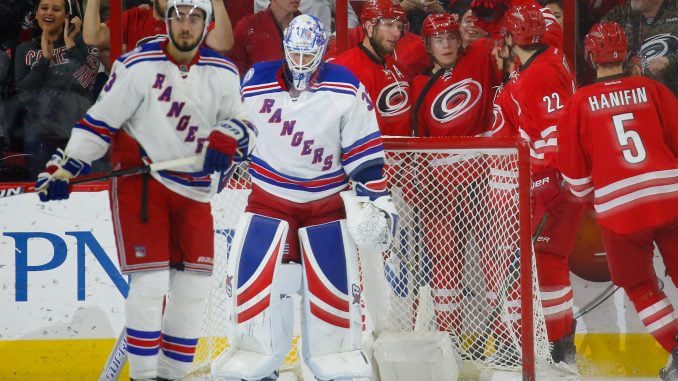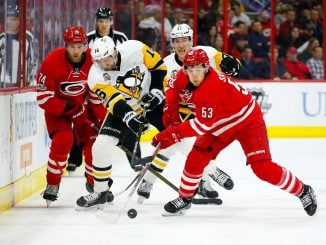
RALEIGH — The Carolina Hurricanes’ path to the playoffs starts in goal, where the team is relying on a bounce-back season from one of (or both) Scott Darling and recently signed Petr Mrazek to give them at least the league-average goaltending that many believe will guide them back to the postseason for the first time since 2009.
Carolina, however, will also be relying on a wave of rookie forwards to catapult it out of mediocrity and anonymity — in both the NHL and the Triangle sports market.
While it’s not much to ask for average goaltending, expecting three rookie forwards — 2018 second overall pick Andrei Svechnikov, 2017 first-rounder Martin Necas and AHL leading goal scorer Valentin Zykov — to carry a big part of the scoring load could be a recipe for disaster.
Luckily, we have advanced stats guru Rob Vollman, ESPN columnist and author of the annual “Hockey Abstract” and “Stat Shot,” to thank for his “translation factors” chart. Vollman (follow him at @robvollmanNHL) has taken data from players in professional, junior and collegiate leagues and conferences across the hockey world and come up with a formula to estimate how a player’s performance in other leagues will translate to the NHL.
He then adjusts the number to the “era” to come up with his final transition factor (also called NHL Equivalency, or NHLe).
As shown in the link in the chart, players from the Kontinental Hockey League (KHL), based primarily in Russia, can be expected to perform at 0.804 in the NHL of the rate they produced in the KHL.
For example, Evgeny Dadonov returned to the NHL’s Panthers last season after spending the previous five years in the KHL. In 2016-17 with St. Petersburg, Dadonov had 30 goals and 36 assists in 53 games.
That’s 1.25 points per game, which when translated using Vollman’s formula (1.25 X 0.804) means one could have expected Dadonov to register right around a point per game.
Vollman’s formula works out pretty well in this case: Dadonov finished with 28 goals and 37 assists in 74 games — or 0.88 points per game. Not perfect, but certainly a good benchmark.
The formula works for 2017 second overall pick Nolan Patrick as well. After averaging 1.39 points per game in his final Western Hockey League season, Patrick — based on Vollman’s 0.302 WHL translation factor — should have averaged 0.42 points in his rookie season. In 73 games with the Flyers, Patrick had 30 points in 2017-18 — 0.411 points per game.
The variables of an NHL season make it impossible to turn this into an exact science. First overall pick Nico Hischier and straight-from-college defenseman Will Butcher, teammates with the Devils, both outperformed Vollman’s projection, while Washington’s Christian Djoos, for example, managed just 14 points in 63 games while projected to have nearly twice that (26.9).
To me, it’s still a worthwhile exercise to see what Vollman’s formula will predict for Carolina in 2018-19. So what can the Hurricanes expect from Necas, Svechnikov and Zykov if they play a full season next year?
Let’s start with Zykov, who led the AHL in goals last season with 33 and had 54 points in 63 games. Vollman’s AHL translation factor (0.486) is his most tested — far more players make the jump from the AHL to the NHL than any other place.
Based on Vollman’s numbers, Zykov (0.85 points per game in the AHL last season X 0.486) should get just shy 0.413 points per game next year — nearly 34 points for a full season.
The Ontario Hockey League is a distant second to the AHL as far as the number of players who have made the jump right to the NHL, but the 75-player sample size gave Vollman a 0.323 translation factor.
Which bring us to our second player: Svechnikov. The Barrie Colts winger was arguably the OHL’s most dangerous player last year, scoring 40 times and adding 32 assists in just 44 games.
His 72 points worked out to a shade under 1.64 points per game. When computed with Vollman’s 0.323 OHL factor, Svechnikov is projected to register at 0.53 points per game, or about 43.5 points in an 82-game campaign.
Finally, a look at Necas. Vollman’s linked-to-above chart does not have a translation factor for the Czech Extraliga, where Necas has played the last two seasons. But an Excel download on his site includes an Extraliga translation factor of 0.457. Unlike the other leagues, the Extraliga factor is not era-adjusted, due to the limited sample size of just five players.
Necas had 17 points in 24 games last season (0.708 points per game), nearly double his output from the previous season. At the 0.457 translation factor, Necas is projected to have 0.32 points per game, an output of 26.5 points over an 82-game season.
In all, Vollman’s translation factor projects 104 points for Carolina’s three rookie forwards. Compare that to the departed Derek Ryan (38 points in 80 games), Elias Lindholm (44 points in 81 games) and Lee Stempniak (nine points in 37 games), who combined for 103.4 points when projected to an 82-game season, and the Hurricanes pretty much get a wash.
That may not seem overly positive — and it’s not — but when you consider the surplus of goals Carolina can expect with Micheal Ferland (21 goals last season), Jordan Martinook (six goals), Dougie Hamilton (17) taking rosters spots from forwards Marcus Kruger (one goal), Joakim Nordstrom (two) and defenseman Noah Hanifin (10), the goal production should rise.
Of course, there’s still the possible departures of Justin Faulk and Jeff Skinner — they had 32 combined goals last season — to consider. But as the roster stands now, the Hurricanes should have an increased goal output if their three rookie forwards (with a combined base salary of about $2.4 million) can match or exceed that of Lindholm, Ryan and Stempniak — and Ryan alone will earn $3.125 million this year on his new deal with the Flames.
It could be a net positive for the Hurricanes on the ice — and definitely on balance sheet.



